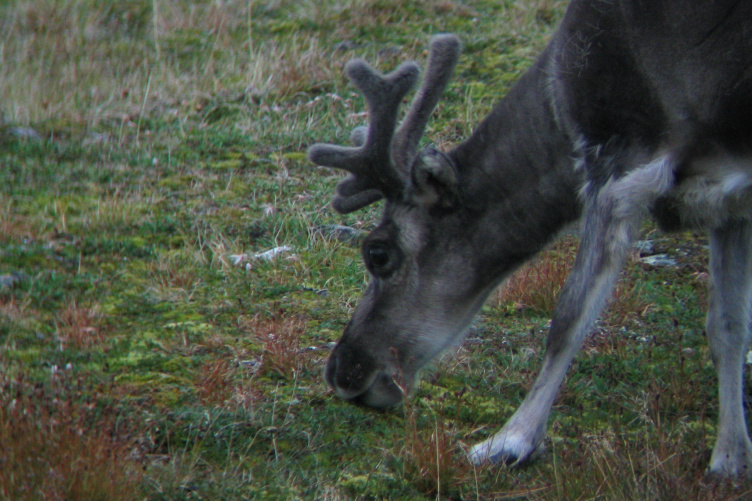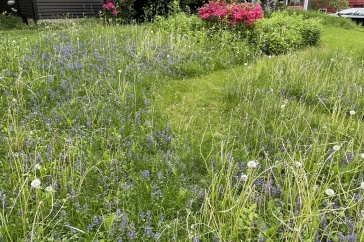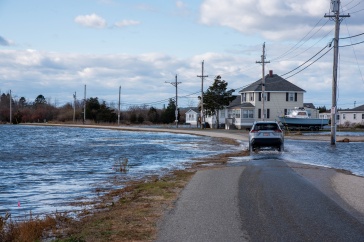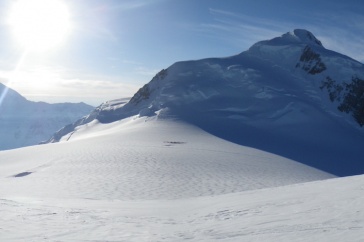
A buck reindeer browses for vegetation in late summer in Svalbard, Norway. Photo by Eric Ropstad.
As the Arctic rapidly warms from climate change, reindeer are responding by eating different foods available during the longer growing seasons. These dietary changes are likely a driving force behind the increasing reindeer populations in recent years, scientists say.
As part of a new study published in the journal Polar Biology, an international team of researchers also determined that stable isotope analysis — a scientific technique to trace animal diets back to their source — can reliably indicate long-term shifts in herbivore diets due to the changing polar climate.
The Norwegian archipelago of Svalbard above the Arctic Circle is home to small reindeer that live in narrow valleys and munch on moss, grass, and woody shrubs during the growing season. Researchers from the University of Chicago and the University of New Hampshire partnered with scientists in Scotland and Norway to determine what vegetation is available now that the growing season is longer and if that correlated with a change in reindeer diets. All reindeer in Svalbard are wild, and therefore their diet would reflect changes in native plant communities rather than changes in the reindeer herding practices of the indigenous Sámi people. The researchers found that with less persistent snow cover, grasses — the reindeer’s preferred food item — tend to thrive, so these herbivores chow down on their favorite meal and don’t have to settle for eating nutrient-poor mosses.
“Reindeer and other herbivores have a different food supply than they did before, and it has helped these mammal populations to expand in size,” says Lily Zhao, a Ph.D. candidate at the University of California, Santa Barbara, and lead author on the study. That may be a boon for reindeer, but Zhao cautions, “When you increase the population size of one species, it can have ecological consequences for other species in that region, so it could become a cascade of effects.”

Zhao, who conducted the research as part of her senior thesis at the University of Chicago, first became interested in studying reindeer in 2012 when she participated in a UNH program called Northern Ecosystems Research for Undergraduates. As part of that program, she spent time in Sweden studying reindeer antlers and bones and speaking to the Sámi people about their reindeer herding practices. Still intrigued by the topic, she decided to collect reindeer hair samples from Svalbard for stable isotope analysis the following year to find out how the changing climate could be affecting their diets, for better or worse.
The stable isotopes of an element like carbon — commonly called carbon-12 and carbon-13 — have the same number of protons but a different number of neutrons than the original element. Stable isotopes can be taken up by plants and animals from the air, water, and nutrients around them. Stable isotope analysis allows scientists to find clues about dietary and environmental changes over long time periods, which is reflected in the ratio of carbon-12 to carbon-13 in whatever samples are collected.
Erik Hobbie, a UNH research professor at the Earth Systems Research Center and co-author on the study, uses stable isotope analysis to study plants, soil, and mushrooms in his other research. Hobbie says that it’s difficult to assess changes in plant communities directly from the carbon isotopic ratio of plants because it’s too variable. Instead, reindeer serve as a reliable integrator of the plants on the landscape; there’s a wealth of information in their hair, which is composed of pure keratin (just like human hair and nails). By running stable isotope analyses on reindeer hair, scientists can monitor not only what they have eaten, but also any changes in their surroundings and in the atmosphere.
"When you increase the population size of one species, it can have ecological consequences for other species in the region, so it could become a cascade of effects."
“Essentially, the reindeer were our vegetation sampling devices, and through them we could see that the Arctic plants were responding to the increasing atmospheric CO2 levels and the warming trend in Svalbard,” Hobbie says. “It’s quite a novel approach that could have wide applications throughout the Arctic.”
Zhao and her co-authors compared these results with satellite imagery on the vegetation growth, and found that there was indeed a lengthening of the growing season. She notes that if these changes spread further south to mainland Scandinavia, it could affect the Sámi people and their reindeer herding practices.
“This study will allow us to untangle complicated ecological dynamics and help reindeer herders anticipate how global environmental change, when combined with shifting land-management practices, will affect reindeer herds and Sámi livelihoods,” she adds.
The Institute for the Study of Earth, Oceans, and Space (EOS) is UNH’s largest research enterprise, comprising five centers with a focus on interdisciplinary, high-impact research on Earth and climate systems, space science, the marine environment and seafloor mapping. With more than $43 million in external funding secured annually, EOS fosters an intellectual and scientific environment that advances visionary scholarship and leadership in world-class research and graduate education.
-
Written By:
Rebecca Irelan | Institute for the Study of Earth, Oceans, and Space | rebecca.irelan@unh.edu | 603-862-0990



















































